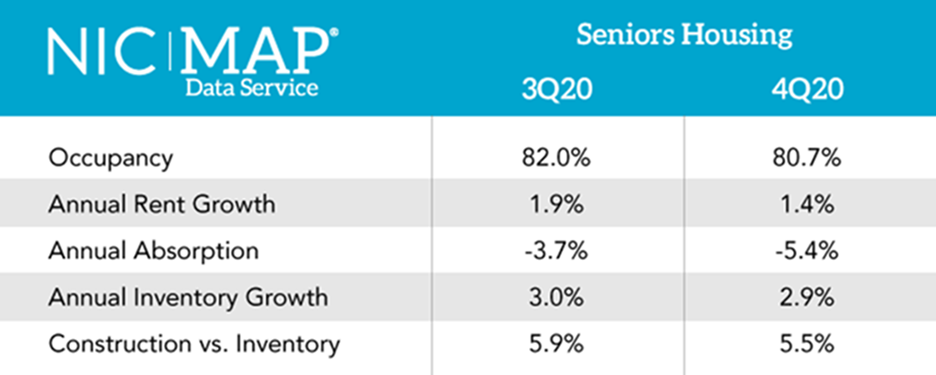ANNAPOLIS, Md. — Private-pay seniors housing occupancy in the United States decreased 130 basis points in the fourth quarter of 2020 from 82.0 percent to 80.7 percent, a record low. Since the first quarter of 2020, occupancy fell by 680 basis percentage points.
That’s according to new data from the National Investment Center for Seniors Housing & Care (NIC), an Annapolis-based nonprofit firm that tracks industry data gathered from 31 primary metropolitan markets. Private-pay seniors housing comprises independent living, assisted living and memory care.
“Seniors housing occupancy declines were less pronounced in the fourth quarter than the previous two quarters, though the fourth quarter decline is still quite large from a historic perspective,” says Beth Burnham Mace, NIC’s chief economist. “The surge in COVID-19 cases following Thanksgiving and Christmas suggests further disruption lies ahead. That said, the recent distribution of the vaccines should soon provide some relief.”
The data show large disparities between occupancy rates across metropolitan markets. San Jose (88.5 percent), San Francisco (86.9 percent) and Seattle (84.8 percent) had the highest occupancy rates of the 31 metropolitan markets that encompass NIC’s primary markets. Houston (73.5 percent), Cleveland (76.6 percent) and Miami (76.7 percent) recorded the lowest.
“The COVID-19 pandemic has impacted move-ins and move-outs across senior living properties,” says Chuck Harry, chief operating officer of NIC. “Move-ins slowed as operators enacted moratoriums to keep residents safe and as safety protocols limited new leasing activity, while move-outs have been affected as residents moved to higher-acuity care settings.”
Separately, inventory growth slowed sharply for assisted living with 1,626 units added in the primary markets, the fewest since the third quarter of 2013.
To view the full report, click here.

